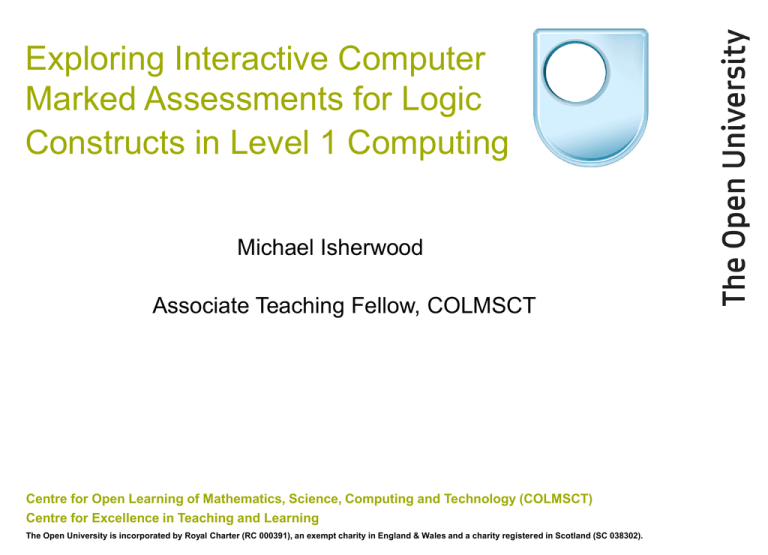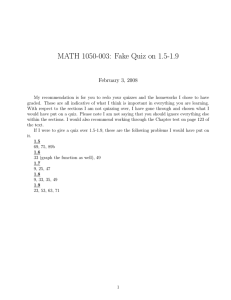Isherwood, M. (2009) 'Exploring Interactive Computer Marked Assessments for Logic Constructs in Level 1 Computing.' PowerPoint presentation from the Making Connections Conference 2009, The Open University.
advertisement

Exploring Interactive Computer Marked Assessments for Logic Constructs in Level 1 Computing Michael Isherwood Associate Teaching Fellow, COLMSCT Centre for Open Learning of Mathematics, Science, Computing and Technology (COLMSCT) Centre for Excellence in Teaching and Learning The Open University is incorporated by Royal Charter (RC 000391), an exempt charity in England & Wales and a charity registered in Scotland (SC 038302). Presentation Summary • • • • Project Aims and Background The Quizzes Logical OR Analyses Results and Student Views Project Aims - summary • Support students in their understanding of new and difficult parts of M150 (in effect, Block 2) • Confirm understanding prior to tma feedback • Investigate extension to other computing courses • Through better understanding, aid retention Background • Students find getting to grips with programming difficult • This leads to frustration and dropping out of M150 (and therefore further computing courses) Background - TMA02/03 Marks On-Line Quizzes • 6 Quizzes on 2008J and 2009B presentations – – – – – – Structured English Conditions, truth and trace tables Basic JavaScript Selection - the if statement Repetition - the while statement Repetition - the for statement Results following are from 2008J up to March Example Question Quiz 4 Q2 • 71% correct at 1st attempt • Only 4% wrong after 3rd attempt Note Feedback after 1st attempt After 2nd attempt the correct answers remain, so student concentrates on incorrect answer(s) Logical OR CP5D A person with body temperature outside the range 35oC to 37oC is viewed as requiring medical attention. Within this range the temperature is considered normal. Write a compound condition that evaluates to true for requiring medical attention, using temp for temperature (in oC) (temp < 35) OR (temp > 37) • 24% correct 1st attempt and 43% after 3rd attempt • Some learning as earlier logical AND only 29% after 3rd attempt Analysis of OR On (temp < 35) OR (temp > 37) 1st Attempt AND and 22 5 && 1 & 0 OR 56 or || 12 2 ¦¦ 0 unit 12 % • 70% correct in principle with 56% absolutely correct • 28% incorrectly go for AND etc •12% of responses included unit (g mm nm oC) Again an improvement on earlier logical AND question where 62% and 19% are comparative results No improvement in omitting unit (10% in logical AND) and no difference between unit depending on familiarity or difficulty Comparison Operator Analysis The 5 variants are : (age<17) OR (age>=60) (mass<53) OR (mass>=63) (len<=219) OR (len>=221) (WL<=400) OR (WL>=700) (temp<35) OR (temp>37) • 49% chose < when correct but only 14% chose <= when correct • 69% chose > when correct but only 28% chose >= when correct • Some 3% chose =< and/or => Interpreting boundary value operators (and values) creates an issue when having to apply from text – “with body temperature outside the range 35oC to 37oC” JavaScript Logical OR Example SY6D A shop waives address evidence on credit card sales when the customer's status is that of existing customer or when the purchase amount is under £40. In the following compound statement expressing this situation drag in the symbols required. < <= = == > >= != AND OR & && || ( amount 40 ) ( status 'existing' ) ( amount < 40 ) || ( status == 'existing' ) Note that in JavaScript (as in other programming languages) many symbols differ from the pseudocode symbols eg || for OR and == for = JavaScript Logical OR Conclusions This was the last question in this JavaScript quiz and all JavaScript symbols had featured in earlier questions • 74% chose “OR” with 65% correct with || and 4% with ¦¦ • not a great improvement on 70% earlier • 25% chose && (and) • thus virtually everyone used a logical operator • < selected by 94% • == correctly selected by 71% but 22% selected = which is the assignment operator Are the Quizzes valuable for Learning? • Student Feedback says yes • Many students attempted more than once – Quiz 2: 304 attempts by 211 students – Quiz 4: 195 attempts by 171 students • As indicated there is improvement as students progress through question tries and through quizzes • Ultimate proof in retention and throughput to further computing courses Student Responses – Pilot 1 • 96% of students found the quiz enjoyable • 91% found the quiz useful • The majority of students didn’t suggest improvements or make any other comment, however some useful suggestions and observations were made and one or two errors were identified Student Views – feedback sample • makes it clear where to use capitals and put spaces in compound statements • Excellent • ..quite short, but long enough to see if I had principles sorted • Very useful especially with the trace tables • It seemed to work very well • Question 7 does not work • Make question 3 less ambiguous • Should include more difficult questions – stage 1 and stage 2 • Questions about repetition and selection could be less ambiguous if construct – Q2 cont if constructs – Q3 •75% of responses correct at 1st attempt • 3% wrong after 3rd attempt. The majority of the errors were at the boundary, as here, though several students reversed After a 2nd attempt, the correct answers were retained, as shown, for the final attempt. if constructs – Q6 On 1st attempt the number of wrong answers is given along with a reminder of the OR (||) operator's effect. The 2nd attempt has feedback as above and the 3rd attempt starts with all the correct responses retained. A Vision for Student Studies Does Next Section Quiz Section “Pod” + Ppt (IC) Tutor Advice Special Session
